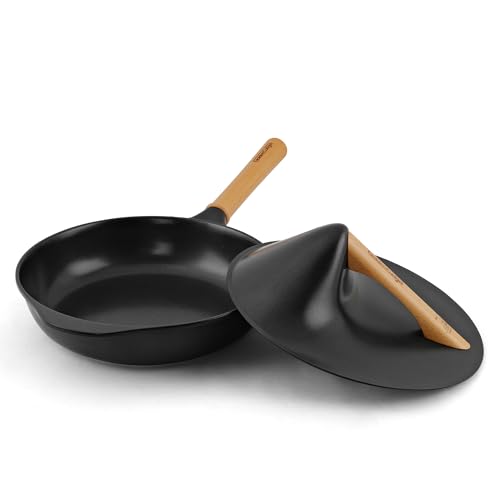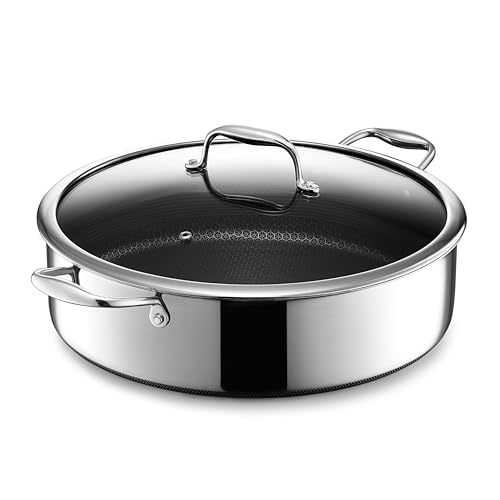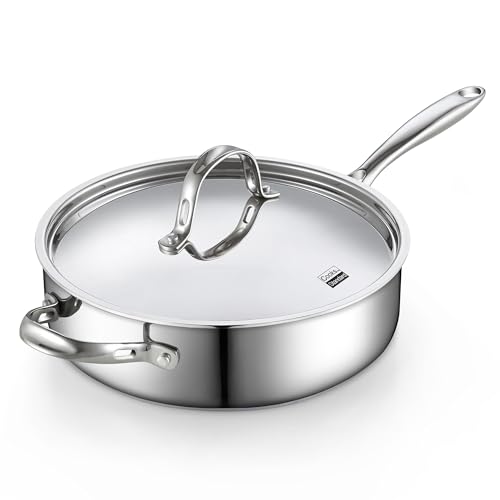In our test kitchen, we’ve seen it all. The drawer overflowing with specialized pans, the non-stick skillet that lost its magic after six months, the heavy cast iron that’s brilliant but a chore to maintain. The dream is always the same: to find that one perfect, do-it-all pan. The one you reach for instinctively for a creamy risotto, a quick stir-fry, a simmering sauce, or even just reheating leftovers. It needs to be responsive, durable, and easy to clean. The search for this culinary unicorn is what led us to the Cuisinart Chef’s Classic 3-Quart Chef’s Pan. On paper, it promised the versatility of a saucier, the capacity of a small pot, and the reliability of stainless steel—all at a price that seems too good to be true. The question we had to answer was, is it?
- Mirror finish. Classic looks, professional performance.
- Aluminum encapsulated base heats quickly and spreads heat evenly. Eliminates hot spots.
What to Consider Before Buying a Sauté Pan
A Sauté Pan, or in this case, a Chef’s Pan, is more than just an item; it’s a key solution for unlocking a world of culinary techniques. Unlike a frying pan with flared sides, a true sauté pan’s straight sides maximize surface area for searing and prevent spills when simmering sauces. A chef’s pan, like the Cuisinart model we’re examining, offers a hybrid design with a wide bottom and sloped, rounded sides, making it a master of versatility. It’s designed for everything from reducing a red wine sauce without a whisk getting caught in a corner to tossing pasta and vegetables with ease. The primary benefit is having one functional piece of cookware that can replace several others, decluttering your kitchen and simplifying your cooking process.
The ideal customer for this type of product is a home cook who is moving beyond basic frying and wants to explore more sophisticated dishes like sauces, braises, and one-pan pasta recipes. It’s for someone who appreciates the precise heat control of stainless steel and is willing to learn the proper techniques to prevent sticking. However, this pan might not be suitable for those who prioritize the effortless food release of a non-stick coating above all else or for cooks who need a much larger capacity for family-sized meals. If convenience is your absolute top priority, a high-quality non-stick or ceramic skillet might be a better fit for your daily eggs and pancakes.
Before investing, consider these crucial points in detail:
- Dimensions & Space: Consider the pan’s footprint. The Cuisinart Chef’s Classic 3-Quart Chef’s Pan has a diameter of around 10 inches and a long handle, demanding a fair bit of space on the cooktop and in your cupboard. Ensure you have adequate room to maneuver it and other pans simultaneously. The depth is also key; its generous basin is great for containing liquids but check that it fits in your oven if you plan to use it for finishing dishes.
- Capacity/Performance: A 3-quart capacity is a sweet spot for couples or small families, perfect for cooking about four to six servings of a sauce or side dish. Performance hinges on heat distribution. Look for pans with an encapsulated aluminum or copper base, which heats more evenly than plain steel, preventing hot spots that scorch food in one area while leaving another undercooked.
- Materials & Durability: Stainless steel is prized for its durability, non-reactivity with acidic foods, and ability to create a great sear. However, not all stainless steel is created equal. Multi-ply construction (like Cuisinart’s MultiClad Pro line) is superior to single-ply with a bonded base, as it provides better heat conductivity up the sides of the pan. The durability of the steel itself is paramount; poor quality steel can be prone to pitting and staining.
- Ease of Use & Maintenance: Think about the handle design—is it comfortable and does it stay cool? Does the lid fit snugly? Is the pan balanced or does it tip easily? While many stainless steel pans are technically dishwasher safe, handwashing is often recommended to maintain their luster. Be prepared for a bit of a learning curve to master heating techniques that prevent food from sticking.
While the Cuisinart Chef’s Classic 3-Quart Chef’s Pan is an intriguing choice, it’s always wise to see how it stacks up against the competition. For a broader look at all the top models, we highly recommend checking out our complete, in-depth guide:
- HEALTHY SKILLET - Switzerland ILAG nonstick surface. Free of PFOA, PFOS, lead, cadmium and other toxic materials that can leach into...
- Premium 12-inch stainless steel fry pan with a lid, featuring a durable and versatile tri-ply construction for even heat distribution...
- NON-TOXIC CERAMIC COATING: Goldencudgel deep saute pan with stay cool handle features premium Alumium and natural ceramic coating free...
First Impressions: A Beautiful Design with Underlying Questions
Unboxing the Cuisinart Chef’s Classic 3-Quart Chef’s Pan, the first thing we noticed was its brilliant, mirror-like finish. It looks professional and feels substantial yet surprisingly light, weighing in at just one pound. The shape is the star of the show; it’s a beautiful, functional hybrid of a saucier and a sauté pan. The wide opening and curved sides immediately brought to mind visions of effortlessly tossing pasta and reducing sauces. The long, riveted “Cool Grip” handle felt secure, and the included stainless steel lid was a perfect, snug fit, essential for its “Flavor Lock” promise. You can see its classic and professional aesthetic for yourself. However, we did notice what some other users have reported: minor finishing imperfections. In our case, the area where the handle meets the pan body wasn’t polished as flawlessly as the rest of the pan. This was a minor cosmetic issue, but it was the first hint that quality control might not be perfectly consistent, a sentiment echoed by users who received units with fingerprints or more significant defects right out of the box.
What We Like
- Excellent versatile shape, ideal for sauces, reductions, and stir-frying
- Lightweight and easy to maneuver
- Includes a snug-fitting stainless steel lid
- Very affordable price point for a stainless steel pan
What We Didn’t Like
- Widespread reports of pitting, staining, and discoloration after minimal use
- Inconsistent heating performance, with popping sounds and hot spots
A Deep Dive into the Cuisinart Chef’s Classic Performance
A pan’s true worth is revealed on the stove, not on the countertop. We put the Cuisinart Chef’s Classic 3-Quart Chef’s Pan through a series of tests, from simple water boiling to creating delicate sauces and searing proteins, to see if its performance could live up to its promising design. What we discovered was a pan of contradictions—one that excels in some areas but fails spectacularly in others.
The Saucier Shape: A Triumph of Versatility
The single greatest strength of this pan is its design. It’s not just a sauté pan; it’s a true chef’s pan. The 3-quart capacity is the perfect size for countless daily tasks. We first tested it with a recipe we knew would challenge it: a creamy pasta al limone, a dish mentioned by one user who had a poor experience with the pan’s material but was drawn in by the shape. The wide, flat bottom gave us ample space to toast garlic in butter, while the high, gently sloped sides made it incredibly easy to toss the cooked pasta with the starchy pasta water, lemon juice, and cheese. There were no sharp corners for ingredients to get stuck in, and the wide mouth made stirring and emulsifying the sauce a breeze. We could see why users praised it as “part wok, part pasta pot, part sauce pan.”
For reducing a balsamic glaze, the pan’s wide surface area was a major advantage, allowing the liquid to evaporate quickly and evenly. Spills were a non-issue thanks to the deep sides. For a quick weeknight stir-fry, it performed admirably, allowing us to toss vegetables without them flying out onto the stovetop. This versatile shape is genuinely a joy to use and feels like it belongs in a much more expensive piece of cookware. If design alone were the metric for success, this pan would be an unqualified winner. It’s this functional excellence that makes the pan’s other shortcomings all the more frustrating.
Heating Performance: An Inconsistent and Noisy Experience
Cuisinart touts the pan’s “aluminum encapsulated base” as a key feature for quick, even heating that eliminates hot spots. In our experience, the reality was far more complicated. On our gas range, the pan did heat up quickly. However, “evenly” is another matter. We noticed that the center of the pan became significantly hotter than the perimeter, leading to uneven cooking when we tried to sauté finely diced onions. Some in the middle started to brown before those on the edges had even turned translucent. This confirms reports from users who complained about food burning in the bottom while the rest remained uncooked.
More alarmingly, we experienced the same “popping/clicking sounds” that numerous users have documented. As the pan heated up, it emitted a series of distinct metallic ticks. This is often caused by different layers of metal expanding at different rates. While it may not affect the cooking process for some dishes, it’s an unsettling noise that speaks to potential issues in the bonding or quality of the materials. We’ve tested dozens of stainless steel pans, including many budget-friendly models, and this loud, persistent clicking is not a normal or acceptable characteristic. A user who returned their first pan only to have the replacement do the same thing confirms that this isn’t an isolated defect but a likely characteristic of the product’s construction. For a pan that needs to withstand repeated cycles of heating and cooling, this raises serious long-term durability concerns.
Material Quality and Durability: The Achilles’ Heel
Here is where the Cuisinart Chef’s Classic 3-Quart Chef’s Pan completely falls apart. Despite its claims of a non-reactive stainless steel surface that won’t discolor, our testing and the overwhelming chorus of user feedback tell a different, troubling story. After its very first use—making the aforementioned pasta al limone with nothing more aggressive than lemon juice and starchy water on low heat—we noticed small, dark spots forming on the cooking surface. These were not food residue; they were permanent discolorations that, as one user aptly noted, “a stainless steel scrubby can’t touch.”
To investigate further, we performed a simple boil test, something many users reported issues with. We filled the pan with plain tap water and brought it to a boil. After pouring out the water and letting the pan cool, we were shocked to see tiny pits—small, tangible divots in the steel—had formed on the bottom. This is a sign of extremely poor-quality stainless steel, which should easily withstand simple boiling water. Our findings directly mirror the worst user experiences, including one who saw the pan’s inner layer “flake away and blacken” on its first use, and another who felt unsafe to cook in it after the “depleted stainless steel coating” was revealed. The absence of an “18/10” stamp on the bottom, a common marker for high-quality food-grade stainless steel, is a significant red flag that we also confirmed. This level of rapid deterioration is unacceptable for any piece of cookware, regardless of its price. The promise of lifetime durability feels entirely hollow when the pan shows permanent damage after a single, gentle use.
What Other Users Are Saying
Our findings are strongly supported by the collective experience of other buyers, which paints a picture of a product with a fantastic concept but deeply flawed execution. On the positive side, those who receive a “good” unit praise its versatility. One user celebrated it as a “good overall reduction or ‘Chef’s Pan’,” noting that after several sautés and deglazings, it remained beautiful with a little care. Another found it “fantastic” for making sauces, exceeding their expectations in both performance and cleanup.
However, the negative feedback is overwhelming and consistent, focusing almost entirely on the poor material quality. One customer’s experience is particularly telling: “Pulled it out of the package, washed it, then tried to boil water… I noticed that the pan already started piting. I’ve never seen a pan do this before.” This mirrors our test perfectly. The theme of immediate failure is common, with numerous reports of “tiny potholes and pits,” “black spots,” and discoloration “within one wash.” The ticking and popping noises are also a frequently cited complaint, leading many to question the pan’s safety and construction. Ultimately, the user sentiment suggests a severe quality control lottery; while some may get a functional pan, a significant number receive a product that fails from the very first use.
How the Cuisinart Chef’s Classic Compares to the Competition
It’s clear that while the Cuisinart Chef’s Classic 3-Quart Chef’s Pan is budget-friendly, its significant quality issues make it a risky purchase. For those seeking a reliable pan, it’s wise to consider alternatives that may cost more but deliver the durability and performance you expect.
1. HexClad Hybrid 7-Quart Sauté Pan
- HexClad’s Hybrid technology features a laser-etched hexagonal nonstick surface that combines both stainless-steel and our TerraBond...
- This deep sauté pan boasts a large cooking surface and has a 7-Quart volume which means you can fry up tons of chicken, braise large...
If you’re looking for the absolute peak of performance and are willing to invest, the HexClad is in a different league entirely. It’s a hybrid pan that combines the searing power of stainless steel with the convenience of non-stick. Its 7-quart capacity is more than double that of the Cuisinart, making it suitable for large families or batch cooking. While the price is significantly higher, you’re paying for superior materials, incredible durability (it’s even metal utensil safe), and flawless heat distribution. This is the choice for serious home cooks who want one pan that can truly do it all without compromise.
2. Cuisinart MCP33-30HN MultiClad Pro 5.5-Quart Sauté Skillet
- EXCEPTIONAL DESIGN: Enjoy mirror finish, classic look and professional performance. Aluminum encapsulated base heats quickly and...
- PREMIUM COOKING: Constructed to last. Drip-free pouring– Flavor Lock Lid
For those who want to stick with the Cuisinart brand but demand better quality, the MultiClad Pro line is the answer. This pan features a triple-ply construction with an aluminum core that extends up the sides of the pan, providing far superior and more even heating than the bonded base of the Chef’s Classic model. It’s heavier, more robust, and built to the standards that Cuisinart’s reputation was founded on. While it costs more, it rectifies every single material and heating flaw we found in the Chef’s Classic, making it a much safer and more reliable long-term investment.
3. Cooks Standard 11-inch Stainless Steel Saute Pan 5 Quart
- Even Heat Distribution: The Cooks Standard Deep Frying Pan is made of 18/10 stainless steel, with a brushed interior and polished...
- With Helper Handle: The riveted handle design offers extra grip support, making it easier to transport and pour out food; It makes...
The Cooks Standard pan represents a fantastic middle ground. It’s more affordable than the MultiClad Pro and HexClad but offers a noticeable step up in quality from the Chef’s Classic. It also features a multi-element aluminum core base for better heat distribution and is made from durable 18/10 stainless steel. With a larger 5-quart capacity, it offers more versatility for bigger meals. This is an excellent alternative for home cooks who want reliable performance and solid construction without breaking the bank.
Final Verdict: A Great Idea, A Terrible Execution
We wanted to love the Cuisinart Chef’s Classic 3-Quart Chef’s Pan. Its shape is brilliantly versatile, its weight is nimble, and its price is incredibly tempting. It has the DNA of a kitchen workhorse. Unfortunately, our testing and a mountain of user feedback reveal a product crippled by severe and unacceptable flaws in its core material. The tendency to pit, stain, and discolor from the very first use, combined with unsettling heating noises, makes it impossible for us to recommend. The risk of receiving a defective unit is simply too high.
Our final advice is to save your money and invest in a pan that will actually last. While the design is excellent, the execution is a profound disappointment. If you’re captivated by the promise of this pan, we strongly urge you to consider one of the more reliable alternatives. For those who still wish to weigh the risks against the low price, you can check the latest price and user reviews online, but we recommend proceeding with extreme caution. Your cookware should be a reliable partner in the kitchen, not a source of frustration and regret.
Last update on 2025-11-07 / Affiliate links / Images from Amazon Product Advertising API







